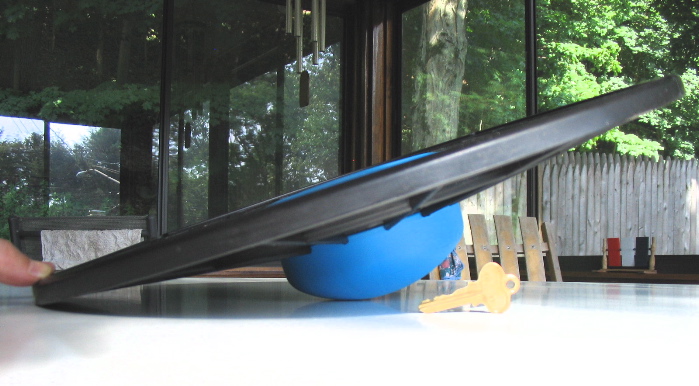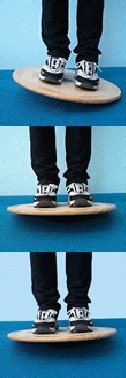Enhance your health with free online physiotherapy exercise lessons and videos about various disease and health condition
wobble board exercises
Wobble board exercises mimic what happens to the muscles, tendons, and ligaments of the feet, ankle and lower legs during running, and as a result build them up for the stresses that they must endure.
Rocker boards are more unstable than balance boards. Use a rocker board for exercises that move your ankle in all possible directions: front to back, side to side, circular clockwise and counterclockwise, and balance on one foot only.
What are Balance Boards?

Balance boards, wobble boards, rocker boards... they look like toys for kids who like skateboards, but the truth is that they are very effective, though overlooked, training tools for overall fitness and athletic ability. And they are fun to use!
Rocker and Wobble/Balance boards have been used for decades to improve balance, coordination and postural control. In fact, in 1965 Freeman et al. were the first to demonstrate the use of balance boards in preventing functional instability of the ankle following injury. Proprioceptive wobble board exercises (rocker and balance boards) has also been demonstrated to be as effective as braces and tape to prevent ankle sprains by assisting in strengthening the muscles and ligaments, influencing reaction times, and restoring proprioception of the damaged structures around the ankle.
Why use a wobble board or balance board? balance board benefits
The body has sensors all around it which sense where parts of the body are even without looking. These sensors are called proprioceptors. If the ankle or lower leg is damaged then the proprioceptors can be damaged also. If you have ever started to turn your ankle over and it has automatically righted itself then this is the proprioceptors working automatically to prevent further injury.
In the injured athlete these sensors will not work so well, increasing the chance of re-injuring the leg or ankle. This is why some people once they sprain their ankle, continue to sprain it repeatedly. Using a wobble board on a regular basis can help retrain the proprioceptors and improve coordination, hence preventing further injury. All the athlete has to do is stand on the board and try to keep it horizontal - without the edges touching the floor.

Wobble Board Exercises
The possibilities for uses are endless, and creativity can definitely be put to good use with balance boards, but here are a handful of several specific ways that balance board training can be used in place of more tedious training methods:
BASIC BALANCE BOARD EXERCISES -
With both feet on wobble board
These three wobble board exercises (move your ankle in all possible directions: front to back, side to side, circular clockwise and counterclockwise) are perfect for beginners, to get used to the feeling of the balance board. Beginners can hold onto a chair or wall at first, if necessary. This can be done while you're watching TV, talking on the phone or whatever else. These are also the standard activities recommended for people with balance problems and those in rehab programs. Once you've mastered this, try kneeling on the board and doing these three exercises. See how long you can maintain your balance and try to increase that time gradually.
Wobble Board Exercises / Balance Board exercise Plan for sprained ankle
(starting easy and getting harder)
- 1. Whilst sitting down place the wobble board under the feet and slowly rotate it a number of times in each direction.
- 2. Stand on the wobble board, feet shoulder width apart. Hold on to a chair for support if needed and rock the board forwards and backwards, then side to side. Do this for 2 to 3 minutes.
- 3. Stand on the wobble board, feet shoulder width apart. Rotate the wobble board round so that the edge of the board is in contact with the floor at all times. Again try this for 2 to 3 minutes.
- 4. Stand on the wobble balance board, again feet shoulder width apart - no chair allowed! Rock the board front to back for 1 minute then side to side for one minute.
- 5. Balance on the wobble board for as long as you can without the edges touching the floor. Aim for over 2 minutes without touching the floor.
- 6. Rotate the wobble board in a circle but do not allow the edge of the board to touch the floor. Aim for 2 minutes.
- 7. Stand on the wobble board with one leg. Rock the board from front to back for 1 minute and then side to side for 1 minute.
- 8. Again stand on the wobble board with one leg only. Rotate the board in a circular motion in one direction for 1 minute then repeat in the other direction.
- 9. Try to balance on the wobble board with one leg only! How long can you go for?
- 10. When you have mastered all of the above you should have strong stable ankles and be an expert. Now try it all with your eyes closed!!
References
- Tennis Fitness for the Love of It: A Mindful Approach to Fitness for Injury ... By Suzanna McGee M S
- Conservative Management of Sports Injuries- By Thomas E. Hyde, Marianne S. Gengenbach
- Balance Training: Stability Workouts for Core Strength and a Sculpted Body: By Karon Karter
- Balance board- From Wikipedia, the free encyclopedia
Return from wobble board exercises to home page
Recent Articles
|
Author's Pick
Rating: 4.4 Votes: 252 |

